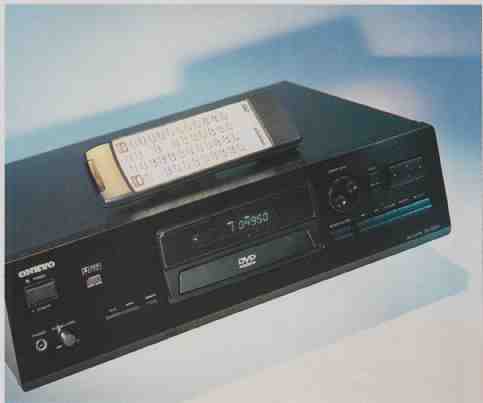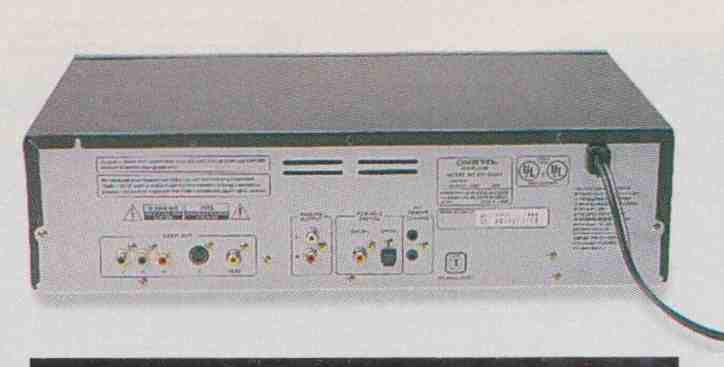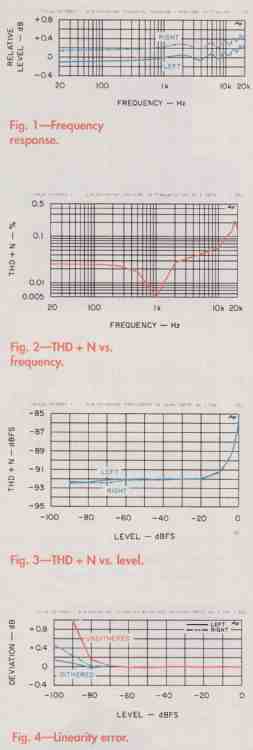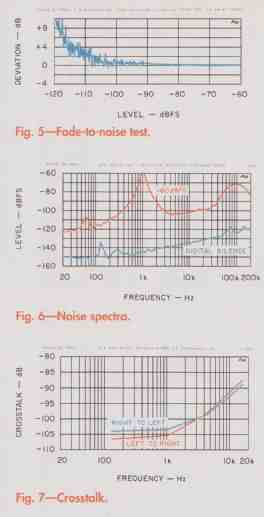|
|
Dimensions: 17½ in. W x 4¾ in, H x 12 in. D (43.5 cm x 12.1 cm x 30.6 cm).
Weight: 9.9 lbs. (4.5 kg).
Price: $599.95.
Company Address: 200 Williams Dr., Ramsey, N.J. 07446; 201/825-7950; www.onkyo.co.jp.


In Japanese, I’m told, “Onkyo” means “sound” or “acoustics.” If so, the company was well named, for it boasts a long and reputable history in sound reproduction. It was also among the first audio companies to embrace the audio aspects of home theater, and the DV-S501 is Onkyo’s latest foray into its video aspects. Onkyo bills the S501 as an “audiophile class DVD/CD player”—perhaps because it has a separate power supply for its analog sections, perhaps because it does not provide internal 5.1-channel Dolby Digital (AC-3) decoding. (I don’t understand why any manufacturer includes 5.1-channel Dolby Digital decoding in DVD players when it logically belongs downstream in an A/V receiver, integrated amplifier, or pre amp/processor.) The player’s analog audio output is strictly two-channel: stereo when playing music CDs, Dolby Surround matrix when playing Dolby Digital surround video DVDs. I was pleased to see the analog signals available from a headphone jack with level control. I was also pleased to see both Toslink optical and coaxial digital outputs, so the S501 should be compatible with any Dolby Digital decoder.
The Onkyo DV-S501 provides video in the three primary consumer formats: composite video, S-video, and component (color-difference) video. The component-video jacks are gold-plated, but the others are not. Oh, yes, there’s a pair of mini-jacks in back for control links to Onkyo’s Remote Interactive A/V receivers and, possibly, other Onkyo components.
Although the DV-S501’s rear panel is pretty conventional, its front sports far more controls than most DVD players, many of which require the remote for al most every operation. The S501 can be operated quite well from the front panel, thank you very much, which could prove to be a lifesaver if you’re as prone to mislaying remotes as I am. Of course, that panel carries the usual transport controls (bi-directional skip, pause, stop, play, and open/close), all arrayed to the right of the disc drawer. But it also carries buttons for navigating on-screen menus, a jog/shuttle dial ("Cinema Scan"), and even a button to dim or extinguish the display. When the S50l is in pause mode, the "Cinema Scan" dial enables you to move backward or forward, frame by frame; in play mode, the shuttle ring controls speed and direction.
As well endowed as the DV-S501's front panel is, the 45-button remote is even more so. It replicates all front-panel transport controls, though buttons handle the "Cinema Scan" functions. You can fast-scan DVDs at two, eight, or 30 times normal speed-forward or backward-by tapping the remote's "FF" or "FR" key multiple times. (These keys also work with CDs, albeit only at two or eight times normal speed.)
To play DVDs at ½, ½, or 1/16 of normal speed, you use the “Slow” key—but for forward play only, not reverse. And for frame-by-frame advance on DVDs, you press “Pause/Step” multiple times. The re mote’s “Title” and “Search” buttons facilitate finding specific portions of a disc; you use the 10-digit keypad to find chapters and tracks by number or by time. Titles, chapters, and tracks can be programmed in whatever order you prefer or set for repeat play, as can any program segments you designate (“A-B” repeat). There’s also a “Random” button if you like your video eggs scrambled.
In addition to the usual controls for selecting DVD soundtrack and subtitle language, turning subtitling on or off, and selecting camera angle, the remote has a rather novel control: “Zoom,” which magnifies a portion of the picture to four times its original area. You can use “Zoom” in normal or slow-motion play, and you can change the area you want to magnify by using directional arrows. (These arrows also are used to navigate through menus.)
The remote’s buttons aren’t backlit and are all the same size, but their labels are in a legible typeface that stands out well against the background colors differentiating function groups. Some might find the remote garish; I think it’s easier to use than the typical unilluminated remote that lacks tactile differentiation. Unlike many other DVD remotes, this one controls only the player itself; it is neither programmable nor pre programmed for other components.
The DV-5501 can play 3- and 5-inch DVDs and audio CDs but cannot play other optical disc formats, such as Video CD.
Measurements
I assessed the DV-S501’s audio performance with a CBS CD-l test disc and its video performance with Lucasfilm THX and Sony test DVDs. There was no point in using the Dolby Labs test DVD, because the S501 does not perform Dolby Digital 5.1 decoding. As I mentioned, that’s sensible. And in this case, it’s also fortuitous, because the player’s digital-to-analog converters aren’t quite as good as I expected from an Onkyo product. They’re not flat-out awful, but some test results are reminiscent of those I used to get from CD players years ago. For example, note the filter ripple and the rising high end (+0.27 dB at 20 kHz) in the S50 l’s frequency response (Fig. 1), not to mention a channel imbalance of almost 0.25 dB.
The DV-S501’s curve of total harmonic distortion plus noise (THD + N) versus frequency (Fig. 2) also reminds me of yesteryear’s converters. Although THD ± N is exceedingly low at 1 kHz (hardly more than 0.005%) and reasonably good from 20 Hz to 2 kHz (less than 0.03%), it rises to 0.056% at 10 kHz and, because of “beats” with the sampling frequency, peaks above 0.2% at 18 kHz. (The curve is for both channels, as their performance was too similar to tell apart.)
Thanks to the DV-S501’s extremely low midband distortion, the curves for THD + N versus level, which are taken at 1 kHz, are impressive (Fig. 3). Maximum distortion, corresponding to just 0.0052%, occurs at 0 dBFS and drops rapidly below that point. Linearity also is quite good (Fig. 4):
Error is essentially nonexistent from 0 to —70 dBFS with undithered signals and to —80 dBFS with dithered data. Worst-case error is 1 dB at —90 dBFS with undithered signals, 0.5 dB at —100 dBFS with dithered. This player also fared well in the fade-to-noise test of linearity error (Fig. 5).
The DV-S50l’s analog stages are excellent. They are virtually noise- free, as you can see from the third- octave spectrum analysis of digital silence (Fig. 6). In fact, the noise floor proved to be so low that I ex tended the vertical scale down to —160 dBFS to accommodate the curve. There’s a trace of power-supply ripple at 120 Hz, but, at approximately —135 dBFS, it’s utterly negligible. These results are reflected in exceptionally good signal-to- noise ratios (see “Measured Data”). The top curve in Fig. 6, an analysis of a —60 dBFS, 1-kHz signal, has some 60-Hz hum; a rise in background noise above 30 kHz suggests a modest degree of noise shaping. Using the same —60 dBFS signal, I determined that the S50l’s dynamic range was good, if not earthshaking.
There’s certainly room for improvement in the Onkyo’s quantization noise (—72.3 dBFS), which characterizes the performance of a DAC when exercised over the full 16-bit range. Yet channel separation (Fig. 7), which reflects the performance of the analog electronics rather than the digital, is very impressive.

Fig. 1 -Frequency response
Fig. 2 + N vs. frequency.
Fig. 3 + N vs. level.
Fig. 4—Linearity error.

Fig. 5 Fade-to-noise.
Fig. 6 Noise spectra.
Fig. 7 Crosstalk
The DV-S501’s output level was a bit lower than usual but no cause for concern. Output impedance was reasonably low. The test results for headphone output level and impedance suggest that the player should provide adequate listening volume with a wide variety of headphones and should deliver maximum output to ‘phones that have relatively low impedance (as most consumer models do).
Although the Onkyo DV-S501’s video performance was not quite so perfect as that of some other DVD players I’ve tested recently, the discrepancies were minor and, for the most part, not discernible on the TV screen. On the whole, the levels of video signals generated by the S501—e.g., chroma burst level, sync pulse level, and white level—were a trifle high; black-level accuracy was a bit further off.
Most of the other video test results were fine. Gray-scale accuracy was within 1 IRE, which is as close as I can measure. There was no overshoot on any of the window patterns, suggesting excellent transient response that should assure clean vertical edges—if your monitor can reproduce them. Chroma level and chroma phase accuracy, which relate to color saturation and hue, were within the limits of experimental error; one can’t ask for more. On the other hand, there was measurable chroma differential gain and phase (shifts in color saturation and tint with changes in scene brightness); the errors were rather modest, but I’ve found most DVD players perfect in these respects.
There was no measurable chroma-luma time displacement, so “painting the colors” (adding in the picture’s color information) should not smear the DV-S501’s excellent basic resolution. Luminance-channel response, which determines horizontal resolution, was rather unusual in having a small dip, a few tenths of a decibel, from 1.5 to 3 MHz. The level did return to 0 dB at the color-burst frequency, remained flat at 4.2 MHz, and was down less than 1.7 dB at 5.5 MHz (the limit of the response sweep). That’s really outstanding video response.
Use and Listening Tests
My experience with the Onkyo DV-S501 in my home theater bore out my lab results to a fare-thee-well. Dolby Digital tracks sounded superb, but that was because of the decoder I used, Enlightened Audio Designs’ TheaterMaster Ovation (which I reviewed in last month’s issue). I’m sure every serious audio/videophile will use an external Dolby Digital decoder with the S501 rather than listen to the Dolby Surround mix from the player’s analog outputs. Therefore, I see no point in discussing the Onkyo’s sound any further.
++++++
MEASURED DATA
PCM AUDIO
Line Output Level: 1.91 V at 0 dBFS.
Line Output Impedance: 440 ohms.
Headphone Output Level: Maximum voltage, 3.84 V; maximum power, 17.1 mW into 600 ohms and 80 mW into 50 ohms.
Headphone Output Impedance: 112 ohms.
Channel Balance: ±0.12 dB.
Frequency Response: 20 Hz to 20 kHz, +0.27, —0.09 dB.
THD + N at 0 dBFS, 20 Hz to 20 kHz:
Less than 0.212%.
THD + N at 1 kHz: Below —85.7 dBFS from 0 to —90 dBFS and below —92 dBFS from —30 to —90 dBFS.
Maximum Linearity Error: Undithered recording, 1 dB from 0 to —90 dBFS; dithered recording, 0.48 dB from 0 to —100 dBFS.
S/N: A-weighted, 128.1 dB; CCIR weighted, 119.1 dB.
Quantization Noise: —72.3 dBFS.
Dynamic Range: Unweighted, 92.9 dB; A-weighted, 96 dB; CCIR-weighted, 86.7 dB.
Channel Separation, 125 Hz to 16 kHz:
Greater than 87.7 dB.
VIDEO
Luminance Frequency Response: +0, —0.3 dB to 4.2 MHz; —1.7 dB at 5.5 MHz.
White (Luminance) Level: 104 IRE.
Black-Level Accuracy: 0.6 IRE high.
Gray-Scale Linearity: Within 1 IRE.
Chrominance Frequency Response:
Less than 10.2 dB down at 2.75 MHz. Chroma Level Accuracy: 98% to 100%, depending on color.
Chroma Phase Accuracy: Within 10, depending on color.
Chroma Differential Gain: Within 8% (0.7 dB).
Chroma Differential Phase: Within 5°.
Chroma-Luma Time Displacement: No measurable error using THX disc. Overshoot: 0 IRE.
Chroma Burst Level: 42 IRE, peak to peak (0.4 dB high).
Sync Pulse Level: 42 IRE (0.4 dB high).
++++++++++
Its video performance is, however, worth discussing. It was excellent except for the chroma differential gain and phase errors, which were noticeable only in yellows and greens on test patterns and not on regular DVDs. I was particularly impressed with the cleanliness of the luminance and chrominance information. Snow (luminance noise) and color shifts and blotches (chroma amplitude and phase noise) were hard to discern, even on test signals. Whether this was due to the DV-S501’s 10- bit video DACs or not is moot; the results are what count, and they were superb.
Horizontal resolution was also impressive. The narrowest portion of the Snell & Wilcox test-pattern wedge (corresponding to a video frequency of 5.5 MHz) was clearly resolved, as was the 5.75-MHz grid on the same pattern. I have little doubt that the DV-S501 can deliver far more than 460 lines (the visual equivalent of a 5.75-MHz video signal); you’ll just need good pro gram material and a good monitor to see it.
The controls worked well and logically. Slow-motion, freeze-frame, and high-speed operation were perfect. The DV-5501 found fully encoded “I” frames reliably, never getting hung up on “P” or “B” frames that don’t contain enough information to create a stable picture on their own. However, as I’ve stated in the past, the DVD format does not allow smooth slow motion or smooth scanning; DVD supports only frame-by- frame motion, at an accelerated or a retarded rate. But at least the picture doesn’t “tear” when you use these special effects, as it does with videotape!
I’m somewhat in a quandary as to what overall rating the Onkyo DV-S501 deserves. The test results are not as impressive as those from a number of other DVD players I’ve tested, but in many applications, the poorer numbers don’t count. Who cares if the S501 doesn’t have the most exotic audio D/A converters if you use a downstream de coder and aren’t using those DACs at all? And except for the chroma differential gain/phase error (which I didn’t notice when watching commercial DVDs), the pictures this player delivers are really very satisfactory. On the positive side, this is a player that can be operated from its front panel and whose remote, though not illuminated, is easy to use. Check it out for yourself.
Adapted from 1998 Audio magazine article. Classic Audio and Audio Engineering magazine issues are available for free download at the Internet Archive (archive.org, aka The Wayback Machine)